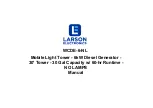
SIEPCYEUOQ2V01A Q2V Technical Manual
633
Load Tolerance
Cooling Capability
Overload Characteristics
(at 100% motor load)
This motor is designed to withstand increased
temperatures during continuous operation in the low
speed range (10% base frequency).
The motor operates continuously at 10% to 100% base
frequency. Operating slower than 10% speed at 100%
load will cause motor overload.
3 : CT 100:1 SpeedRange
Use this setting for vector motors with a speed range for constant torque of 1:100.
The speed control for this motor is 1% to 100% when at 100% load. Operating slower than 1% speed at 100%
load will cause motor overload.
Load Tolerance
Cooling Capability
Overload Characteristics
(at 100% motor load)
This motor is designed to withstand increased
temperatures during continuous operation in the low
speed range (1% base frequency).
The motor operates continuously at 1% to 100% base
frequency. Operating slower than 1% speed at 100% load
will cause motor overload.
4 : PM VTorque
Use this setting for PM motors with derated torque characteristics.
The overload tolerance decreases as motor speed decreases because the cooling fan speed decreases and the ability
of the motor to cool decreases in the low speed range.
The overload tolerance characteristics of the motor change the trigger point for the electronic thermal protector.
This provides motor overheat protection from low speed to high speed across the full speed range.
Load Tolerance
Cooling Capability
Overload Characteristics
(at 100% motor load)
This motor is designed to withstand increased
temperatures during continuous operation at rated speed
and rated torque.
If the motor operates continuously at lower speed than
rated rotation speed at more than 100% torque, the drive
will detect
oL1
. The drive triggers a fault relay output and
the motor coasts to stop.
5 : PM CTorque
Use this setting with a PM motor for constant torque that has a speed range for constant torque of 1:500.
The speed control for this motor is 0.2% to 100% when at 100% load. Operating slower than 0.2% speed at 100%
load will cause motor overload.
Summary of Contents for Q2V Series
Page 2: ...This Page Intentionally Blank 2 SIEPCYEUOQ2V01A Q2V Technical Manual...
Page 12: ...12 SIEPCYEUOQ2V01A Q2V Technical Manual...
Page 18: ...i 2 Legal Information 18 SIEPCYEUOQ2V01A Q2V Technical Manual...
Page 26: ...1 2 Features and Advantages of Control Methods 26 SIEPCYEUOQ2V01A Q2V Technical Manual...
Page 38: ...2 8 Installation Methods 38 SIEPCYEUOQ2V01A Q2V Technical Manual...
Page 70: ...3 3 Main Circuit Wiring 70 SIEPCYEUOQ2V01A Q2V Technical Manual Models B006 B012...
Page 102: ...3 17 Motor Application Precautions 102 SIEPCYEUOQ2V01A Q2V Technical Manual...
Page 138: ...4 12 Test Run Checklist 138 SIEPCYEUOQ2V01A Q2V Technical Manual...
Page 144: ...5 2 European Standards 144 SIEPCYEUOQ2V01A Q2V Technical Manual...
Page 145: ...Standards Compliance 5 5 2 European Standards SIEPCYEUOQ2V01A Q2V Technical Manual 145...
Page 146: ...5 2 European Standards 146 SIEPCYEUOQ2V01A Q2V Technical Manual...
Page 266: ...7 10 Troubleshooting Without Fault Display 266 SIEPCYEUOQ2V01A Q2V Technical Manual...
Page 284: ...8 6 Storage Guidelines 284 SIEPCYEUOQ2V01A Q2V Technical Manual...
Page 312: ...10 10 Peripheral Devices and Options 312 SIEPCYEUOQ2V01A Q2V Technical Manual...
Page 430: ...11 21 Parameters Changed by PM Motor Code Selection 430 SIEPCYEUOQ2V01A Q2V Technical Manual...
Page 731: ...SIEPCYEUOQ2V01A Q2V Technical Manual 731 Z Z pulse Auto Tuning 125...
















































